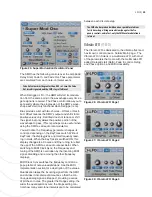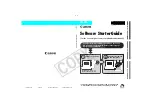
36
| GLOBAL SETTINGS
Tables
Figure 44: Tables Panel
Previous to v5.0, there was only a table provided for
Velocity response. Now you will
fi
nd separate tables for
the Mod Wheel (MW Table) and Aftertouch (AT Table)
control signals as well.
The Mod Wheel table output here is sent to the Modulation
Source list; there is another Mod Wheel table in the Vibrato
LFO section exclusively for the Vib LFO control.
Control
Description
Type
There are 7 types of velocity tables avail-
able, numbered 0-6. The display will give
you an idea of the shape. Inverted velocity
tables are provided.
Intensity Increases the curvature or slant of the
selected table
Offset
The bias offset of the current table’s val-
ues. Emphasizes (or deemphasizes) the
impact of the table’s shape.
MW, AT, Vel Table Controls
Table 3:
Your MIDI keyboard controller may also have its own velocity
curves, which you will want to adjust fi rst. Use table type 0
when checking your keyboard controller, and then adjust the
Solaris velocity table to your particular playing style.
Key Level
(KeyLv)
Figure 45: Key Level Panel
Four keytracking (Key Level) tables have been added
as control signals (Mod Sources). These take the nor-
mal Note input and scale it across the table as output.
Key Level appears as KeyLv1-KeyLv4 in the mod
source list.
In each of the corners you will see small numeric
displays. The lower two are MIDI Note values; the up-
per values control how much the note value is scaled
(should be a percentage, but for simplicity I used 0-127
for everything, where 127 = 100%).
You can click on the vertical bars and drag them left/
right, setting the upper and lower key limits for the
table. Clicking directly on the blue dots, then dragging
them up or down allows one to adjust the scaling.
Because these use the same graphic display as the MultiSeg-
ment Env in the Scope library, there persists a graphics bug in
the preset settings. The numeric fi elds will always represent
the accurate preset value, but the graphic may not refl ect
these values all the time.
Modulation Chains (ModChn)
Figure 46: Modulation Chains Panel
Modulation Chains are another new feature in Solaris
5, which provides additional modulation control where
the current modulation path is limited, such as with
fi
lter
resonance, which normally can only have a single mod
source. This section consists of three ModChains, la-
beled 1-3 vertically on the right side of the panel. Each
ModChain has three inputs with amount controls. Each
of the three ModChains can act as either a 3-input
modulation mixer, or a modulation mixer with sidechain
control. Clicking on any of the + boxes change it to an
arrow, which now routes the source on the left as a
controller for the source to it’s immediate right.
Refer to the screen shot when reading the following section:
•
ModChain 1 is con
fi
gured as a 3-input modula-
tion mixer. Select a modulation source and set the
amount. The + sign indicates that the modulation
sources are being added in the mixer.
•
ModChain 2 is con
fi
gured as a 2-channel modula-
tion mixer (lfo-a + SMO) with sidechain modulation
of lfo-a by Env1.
ModChain3 is con
fi
gured as 1
•
modulation source
(Seq B) with 2 sidechain controls (Seq A and Env 2)
Содержание Solaris V5
Страница 1: ...User Guide V5 By John Bowen and Brent Garlow ...
Страница 30: ...30 SOUND MODIFIERS Figure 35 Looping Envelope Diagram ...
Страница 47: ...John Bowen Synth Design www johnbowen com ...












































